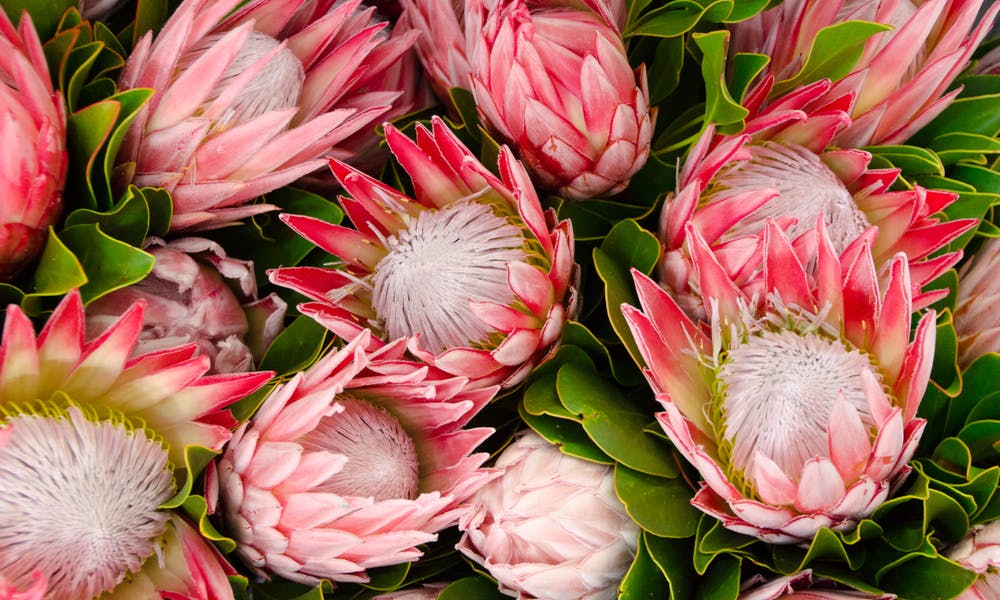MENU
Add the Protea Flower to Your Garden for a Unique Touch

Flowers are a colored and perfumed gift from Mother Nature. They exist in a wide variety of colors, forms, and scents and can express a mixture of sweetness, affection, and love at the same time. Flowers can be your best tool to express all that your heart’s feelings of love and consideration but also to bring bright colors and beauty into your garden.
In this article, we are going to talk about “protea,” from the Proteaceae family. It includes nearly 100 plants from South Africa. The protea is a family of Mediterranean shrubs very common in the South African landscape. Florists appreciate the longevity of this flower as its disproportionate form is adorned with vibrant colors. The tough green or bluish foliage reminds people of the eucalyptus plant. Because of its astonishing variety of shapes and colors, depending on the species, this flower was named after the Greek god, Proteus and his power of metamorphosis and change.
In this article, the following points are going to be discussed:
- Legends about the protea
- Where do you naturally find the protea flower?
- What are the characteristics of the protea flower?
- How to plant the protea flower?
Legends About the Protea
The protea is one of the oldest flower families on Earth, and it dates to at least 300 million years ago. The Greeks, with their large panel of legends, relate the story of Proteus, the son of Poseidon, as the source of the flower’s name. He was the god of the sea who had the powerful power of knowing all past, present, and future things. Proteus was wary about his power and preferred staying isolated on the island of Pharos rather than to make prophecies. To dissuade those who sought his services, he changed shape at his will so that no one would be able to find him. The protea flower was named for him because of its amazing variety of shapes, colors, textures, and sizes.
Because of this mythological association with Proteus, the Greek god linked to change, metamorphose and transformation, it is not surprising that the protea symbolizes diversity and courage.
Where do You Naturally Find the Protea Flower?
Protea is a type of plant from the Proteaceae family. It includes nearly 100 plants from South Africa. These plants are an integral part of the Cape Floristic Region. Most of the South African Proteas are in this region, which means in the Western Cape, these plants grow along the coast and in the mountainous regions east to Port Elizabeth and move inland, away from the coast.
They are fynbos plants (a natural plant formation characteristic of southern South Africa) and develop in variable soils, which are generally poor with a predominance of mountain sandstone, especially in mountainous regions. They also grow in the Bokkeveld shales.
However even if we find nearly 90% of the proteas in South Africa, a certain number live elsewhere in Africa, including in high-altitude places like Kenya, Tanzania, Uganda, Zimbabwe, and Ethiopia, where they find a climate similar to the South African mountain fynbos.
What are the Characteristics of the Protea Flower?
These small trees are native to southern Africa, and 90% of those growing naturally are found there. The rest grow around eastern tropical Africa. Their family has about 115 species distributed over a small area. This extraordinary variability results from the diversity of terrain, which allows populations to remain isolated and evolve in a distinct manner. The royal protea (Protea cynaroides) is the most famous one of them because it is the emblem of South Africa.
The shrubs generally reach 1 to 3 m, sometimes 8 m in height, emit robust stems from a stem made up of thick and deep roots. In the “royal protea,” the root is a lignotuber, containing starch, which allows it to regrow easily after a fire. The leaves vary in size, shape, and color depending on the species. The protea exists in the form of dried flowers, too. In the 19th century, it was used to create a medicinal syrup.
How to Plant the Protea Flower
You can plant your protea flowers in pots or the ground in light, acid-neutral, draining soil (ideal pH between 5.5 and 6.5). Choose sandy or sandstone soil that is poor in organic matter. Avoid clay or humus soils.
Choose a very sunny exposure, making sure to keep the roots cool. The plant must receive sun at least five hours a day. The “royal protea” in particular does not tolerate the dryness of the soil. Planting in a rock garden is a good compromise because it allows the roots to find freshness under large stones. In their natural environment, plants grow close together to protect themselves from the wind.
Protea resists cold around -6 ° C but sometimes survives peaks down to -10 or -13 ° C once the plant is well established or when the cold gradually settles without the air and soil being too wet.
Nature is full of secrets and wonders that never cease to inspire admiration in the minds of human beings. Among them, we can count flowers, with all the purely visual and olfactory pleasures that they can stimulate.
Because of this mythological association with Proteus, the Greek god linked to change, metamorphosis, and transformation, it is not surprising that, in the language of flowers, the protea symbolizes diversity and courage. If you put it in your garden, this flower can bring a unique look, and create a South African fynbos in your own back yard.
Florists appreciate the longevity of this flower as its disproportionate forms adorned with vibrant colors. This flower does not ask for much, and it is easy to grow; only good soil and sun exposure, but it can bring beauty, originality, and variety very appreciable in your garden that can undeniably charm anyone who looks upon them.

